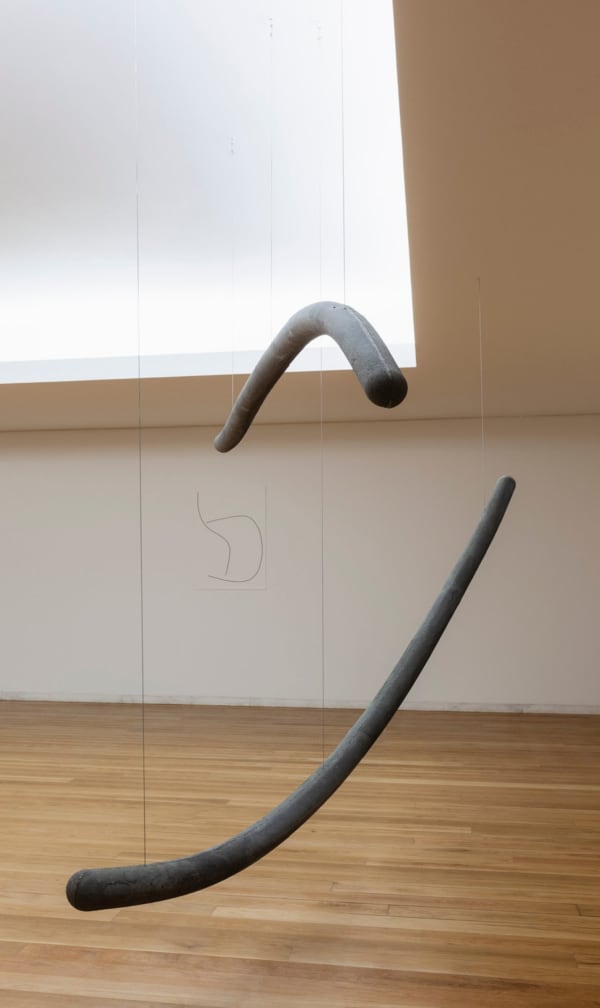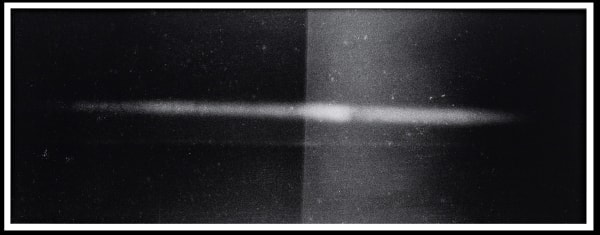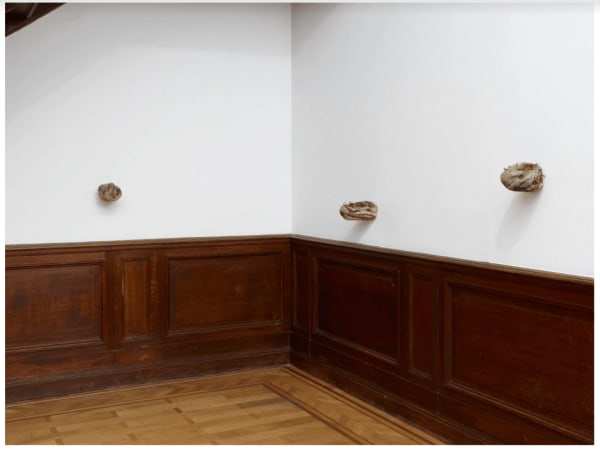Labirintos e abalos sísmicos: Curated by Luisa Duarte and Bernardo José de Souza
Gabriel Abrantes, Daniela Ângelo, Vasco Araújo, Anderson Borba, Vivian Caccuri, Paloma Bosquê, June Crespo, Joana Escoval, Dayana Lucas, Solange Pessoa, Diana Policarpo, Leticia Ramos, Matheus Rocha Pitta, Daniel Steegmann Mangrané, Tadáskía and Adriana Varejão.
We live in a world where everything around us is about to collapse: the climate, capitalism, democracy, worn-out Western epistemologies, false technological promises, the imperative split between nature and culture. If the works brought together in Labyrinths and Earthquakes were asked to respond to such a crisis, it is likely that they would tell us that this is not about fixing things that are collapsing as a way of keeping the alleged order, or escaping the tremors, but rather about inhabiting them. In order words, we should "stay with the trouble".
In a world overcome by cataclysms, political breakdowns and biotechnological transformations, our alleged reality - both fractured and threatened - gains fictional hues, enveloped in an atmosphere of semantic instability, delirium and paranoia. Between the so-called real landscape and the virtual one, which we struggle to differentiate between, we see the emergence of bodies in transformation, organic and inorganic beings, whose hybrid or even artificial nature challenges the idea of nature itself.
Beyond the ontological schism that sees culture and nature as antipodes, this exhibition aims to navigate a topography of elements that emulate the image of something that has never yet existed, revealing traces of a projected humanity, a failed notion of functionality and a sense of nature that is as ambiguous and complex as it is fragile. Free from any human presence, with the exception of Bosch's "meta-painting" (the work itself transfigures humanity) and the inverted medusa (inhuman, superhuman) that welcome us and our petrified smartphones to the gallery, Labyrinths and Earthquakes builds a scenery filled with visual tropes whose semantic nexus moves beyond the limits of individuation: the objects and technologies brought together here are in constant physical and metaphysical tension, permanently producing new sensorial arrangements, whether derived from language or not - or the very idea of the Self.
In this sense, the rooms at Galeria Francisco Fino compose a labyrinth of sorts, in which animated and inanimate beings are turned into chimaeras, or a kind of simulacra of the remains of symbolic and material formations amalgamated across time. Placed in a phantom temporality (neither past nor future), each one of the works, rather than becoming a touchstone of the authenticity of what we call culture or nature, appear precisely to indicate the insufficiency of both concepts when it comes to the multiplicity of worlds that human and non-human histories have come to engender.
Like in a labyrinthine ecosystem, the works interact via their own performativity, which invariably includes the human factor, although this appears to be constantly relativized. Seen together, the works take us to unstable grounds, where it is no longer possible to devise airtight territories, or forge a one-way perspective (subject/object), but, rather, they intertwine myriad differences and witness multiple viewpoints. According to Ana Vujanovic and Bojana Cvejic, "relation is not something that appears between two already individuated things but something that arises by constituting the things themselves as relations." From here, we can deduce that the totality of human and non-human relations is a result of the entanglement of the most diverse creatures, both organic and inorganic, both biotic and abiotic, which ultimately leads to Karen Barad's question: "What if we were to recognize that differentiating is a material act that is not about radical separation, but on the contrary, about making connections and commitments?"
Given that labyrinths embody, simultaneously, order and disorder, unity and multiplicity, precision and detour - as well as evoking a path to be followed, a crossing, which is in itself a driver to see the surroundings, the other and oneself - the present exhibition deals with semantic and epistemological ambiguities and conjures fictional universes, whilst speculating on the dialogical relationships between nature and culture.
As Édouard Glissant writes: "we understand the world better when we tremble with it, for the world trembles in every direction." To tremble with the world and embrace the multiple perspectives of the labyrinthine form - this is how the works brought together here are summoning us to imagine different ways of inhabiting our unstable and turbulent present.
Luisa Duarte and Bernardo José de Souza
-
 Daniela ÂngeloInv. 78, 2021Inkjet print on paper30 x 21 cmEdition of 2 plus 1 artist's proof
Daniela ÂngeloInv. 78, 2021Inkjet print on paper30 x 21 cmEdition of 2 plus 1 artist's proof -
 Vasco AraújoExotismo #2, 2014Coconut, plastic flower, wood table, MP3 sound, headphones150 x 40 x 40 cm
Vasco AraújoExotismo #2, 2014Coconut, plastic flower, wood table, MP3 sound, headphones150 x 40 x 40 cm -
 Vasco AraújoExotismo #3, 2019Coco de mer, plastic palm tree acorn and leafs, wood table, MP3 sound, headphones100 x 90 x 60 cm
Vasco AraújoExotismo #3, 2019Coco de mer, plastic palm tree acorn and leafs, wood table, MP3 sound, headphones100 x 90 x 60 cm -
 Paloma BosquêFossil, 2022wool, Giluform and glass55 x 4 x 4 cm
Paloma BosquêFossil, 2022wool, Giluform and glass55 x 4 x 4 cm -
 Paloma BosquêSwan Tree / Árvore Cisne, 2022wool, Giluform and acrylic paint139 x 72 x 27 cm
Paloma BosquêSwan Tree / Árvore Cisne, 2022wool, Giluform and acrylic paint139 x 72 x 27 cm -
 Vivian CaccuriDescompressão Mosquito, 2023mosquito netting, waxed cotton, cotton, acrylic paint, beads, acrylic resin and brass122 x 98 x 2 cm
Vivian CaccuriDescompressão Mosquito, 2023mosquito netting, waxed cotton, cotton, acrylic paint, beads, acrylic resin and brass122 x 98 x 2 cm -
 June CrespoPulso, 2022ronce, methacrylate, dried flower, raincoat155 x 66 × 76 cm
June CrespoPulso, 2022ronce, methacrylate, dried flower, raincoat155 x 66 × 76 cm -
 Dayana LucasAntropofagias II (2/3), 2018Sculpture and installation in reinforced concrete consisting of two piecesPIECE A: 33 x 275 cm / Diameter 8 cm
Dayana LucasAntropofagias II (2/3), 2018Sculpture and installation in reinforced concrete consisting of two piecesPIECE A: 33 x 275 cm / Diameter 8 cm
PIECE B: 122 x 329 cm / Diameter: 8 cm -
 Leticia RamosFata Morgana, 2018Silver Print100 x 265 cm
Leticia RamosFata Morgana, 2018Silver Print100 x 265 cm -
 Diana PolicarpoBosch’s Garden, 2020Digital animation, sound6 ́55 ́ ́Edition of 2 plus 2 artist's proofs
Diana PolicarpoBosch’s Garden, 2020Digital animation, sound6 ́55 ́ ́Edition of 2 plus 2 artist's proofs -
 Matheus Rocha PittaThe first siren (Beyoncé as Nefertiti), 2019-2020Concrete, paper, chains, Chinese ink and selfie sticks240 x 48 x 48 cm
Matheus Rocha PittaThe first siren (Beyoncé as Nefertiti), 2019-2020Concrete, paper, chains, Chinese ink and selfie sticks240 x 48 x 48 cm -
 Matheus Rocha PittaBrasil #1, #2, #3, #4, #5, #6, #7 and #8, 2013Ilfochrome print50 x 50 cm each
Matheus Rocha PittaBrasil #1, #2, #3, #4, #5, #6, #7 and #8, 2013Ilfochrome print50 x 50 cm each -
 Solange PessoaUntitled, 1999Cement and moss24 x 15 x 13 cm | 24 x 12 x 11 cm | 22 x 16 x 11 cm
Solange PessoaUntitled, 1999Cement and moss24 x 15 x 13 cm | 24 x 12 x 11 cm | 22 x 16 x 11 cm -
 Solange PessoaUntitled, 2019Ceramic and hair120 x 60 x 25 cm
Solange PessoaUntitled, 2019Ceramic and hair120 x 60 x 25 cm



















